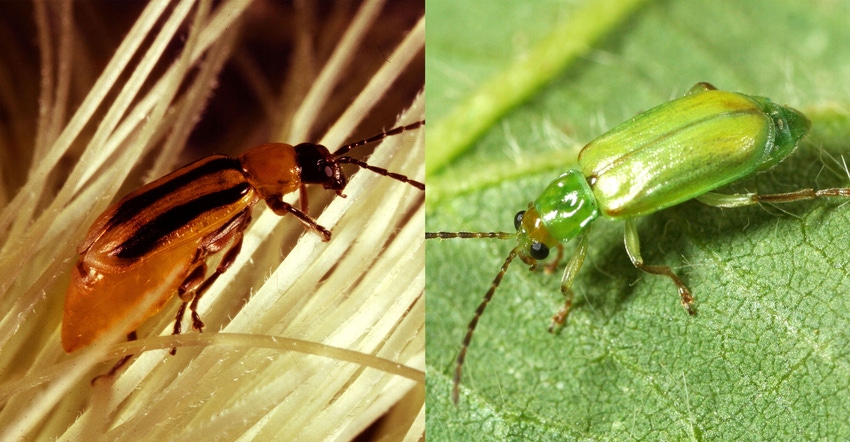November 2, 2021

Never underestimate the power of confusion.
Do you want to slow corn rootworms from developing resistance to our management options? Don’t repeat the same strategies every year. Change it up. Confuse them. Find a way to get rid of those insects that might have "figured out the system" by changing the game.
Some producers try to do that by stacking treatments and using this "system" multiple years in a row. Is that confusing to rootworms? Or, is it just selecting for those that are surviving this more complex system? If we keep using this system year in and year out, we are selecting for those that have this system figured out, too. So, change it up. Confuse those rootworms.
I understand that if something works, we want to keep doing it because it is familiar. However, rootworms are notorious for quickly figuring out systems and overcoming them. Northern corn rootworms developed extended diapause behaviors to overcome corn-soybean rotations. In the eastern part of the Corn Belt, western corn rootworms have shown some evidence of laying eggs in soybean fields, also overcoming rotation as an effective management method.
In Nebraska, treating adult beetles through center-pivot applications of insecticides worked for a brief while, until insecticide resistance appeared. Bt rootworm traits left impeccable root systems in continuous cornfields, until the western corn rootworm developed resistance to all the traits currently available to crop producers. Although not found in Iowa, northern corn rootworm has developed resistance to Bt in North Dakota. What management changes are available? That depends on which type of rootworm beetle is causing you the most problems.
I believe rootworms might be able to overcome everything we throw at them. But, if we confuse them, then we can extend the time from when we adopt a technology to when it begins to fail. Some think that new technologies can keep ahead of rootworms. I think 2021 proved that wrong on many continuous cornfields.
Consider management options
Rotating to a nonhost crop has been very effective for managing western corn rootworms found in long-term corn-corn rotations. However, a significant portion of the northern corn rootworm population can overcome a year of soybeans (or other non-host crop), by not hatching until about 18 months after the eggs were laid in the soil. For long-term corn-on-corn fields with reduced effectiveness to the Bt rootworm proteins and significant corn rootworm injury from western corn rootworm, rotation has been a great option.
Bt rootworm traits are still very effective in many fields. No Bt rootworm trait resistance has been confirmed in northern corn rootworms in Iowa. However, studies conducted by Aaron Gassmann, a professor in the Department of Entomology at Iowa State University, have documented western corn rootworm resistance to all four of the traits in some continuous cornfields across the state. Cross resistance with the three Cry3 traits appears to be common, and random field analysis seems to show it is rather widespread across Iowa. Cry34/35Ab1 doesn’t have cross resistance, but some fields have been confirmed with resistance to all the traits available in 2021.
Digging and evaluating corn roots for injury during July or early August can help us determine the success of the rootworm Bt trait in fields. If a Bt rootworm hybrid averages more than a half node destroyed by corn rootworms, you are experiencing greater-than-expected injury for pyramided Bt traits.
Soil-applied insecticides may be used at planting to protect roots from larval corn rootworm injury. For many, this continues to be a successful option. Early-season dry weather did have an impact on the effectiveness of the treatments in 2021, and some studies show that in very dry Junes, these products aren’t quite as effective. However, I do not think any real resistance to these current treatments has been documented. ISU’s corn rootworm evaluations of various Bt traits and soil-applied insecticides for management of corn rootworm larvae can be found in university annual reports at bit.ly/cornrtwrmisu.
Other tools available
There are a couple more options that have some impact on corn rootworms, but don’t effectively solve the issue of significant rootworm pressure. Insecticidal seed treatments do have some activity on corn rootworms, but don’t seem to offer enough control to manage a situation where insect pressure is significant.
Foliar insecticides on adults can kill the adults present in a cornfield for a short time, which might "thin the herd" somewhat. But, due to the elongated period that adult rootworms emerge and the relatively short time that insecticides effectively kill these adults, multiple treatments would likely be needed to control a high population. Consider that a surviving female is likely to lay between 200 and 500 eggs in the soil, about 6 inches deep, for overwintering into the future. And remember, multiple applications of an insecticide also increase the risk of resistance development.
For 2022, there is a new technology available to fight corn rootworms, although it will have limited availability this coming year. RNA interference (RNAi) provides "gene silencing" for metabolism needed to live. This technology, which is specific to northern and western corn rootworms, silences a gene that triggers the production of a key protein in a rootworm’s gut, which causes the larvae to die in about four to six days.
SmartStax-Pro will be pyramided with Cry3Bb1 and Cry34/35Ab1, giving three modes of action. I have heard it noted several times that this is not the "silver bullet" that won’t have resistance develop in the future — but it is a different management option than we have had available before 2022. Again, do not use it every year until it fails.
Corn rootworms have shown an incredible ability to adapt to almost everything we have used to manage them. Help us all to extend the life of our management systems before additional widespread resistance is found. Vary your management practices. “Confuse” corn rootworms.
DeJong is an ISU Extension field agronomist in northwest Iowa. Contact him at [email protected].
About the Author(s)
You May Also Like






